The timeless stereotype of the mad artist dies hard. But, sometimes there are a few kernels of truth within the myth, or enough examples to sustain it. It seems axiomatic to state that artists have always, with certain exceptions, been poor and economically disadvantaged. The real issue is why there are so many aspiring artists when the chances of escaping genteel poverty and forced bohemianism is such a low percentage gamble? Also, why do artists continue to make art, when for all intensive purposes it simply reinforces their poverty as they grow older.Is the problem that the “starving artist” stereotype actually induces the artist to fall back to victim status?
Because several now famous artists having historically been starving artists, the inherent dramatic potential of being talented but cash-deprived, and the appeal of living a life without material possessions, lends a portrayal to the lifestyle heavily imbued with the romantic. Byron was he first artist celebrity and the image has been grounded in the public consciousness since. If many artists are “starving” , perhaps it is due to a lack of understanding of what the role of art is in our society…
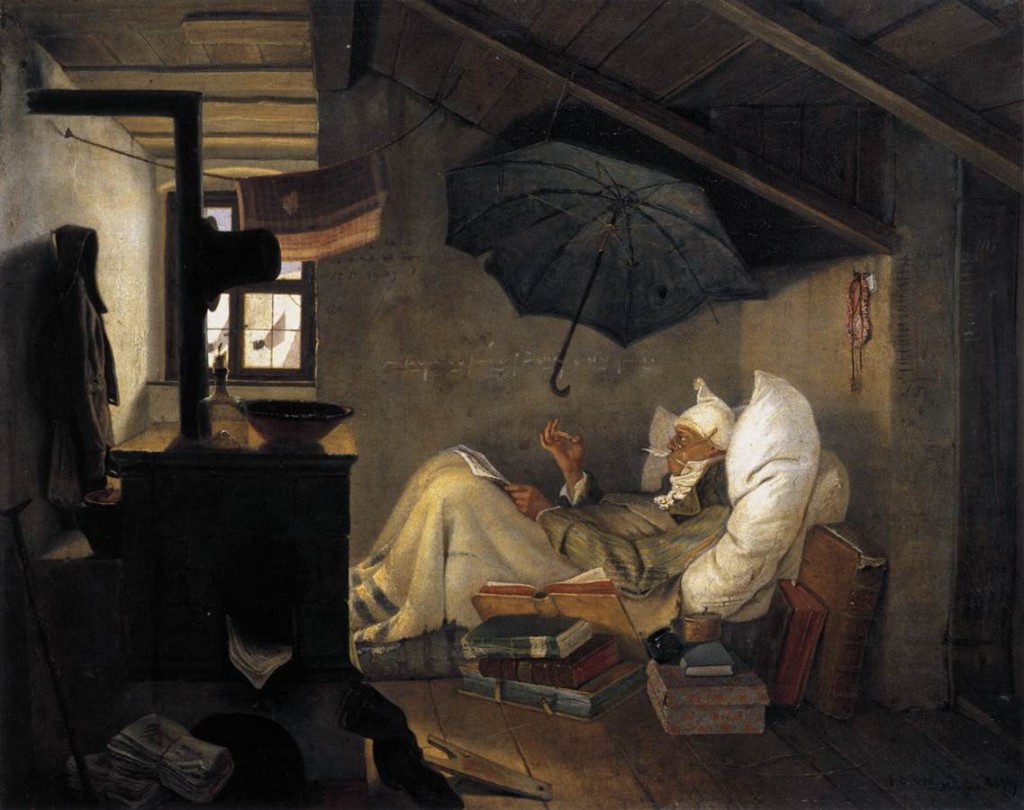
---In “The Poor Poet” (1839), Spitzweg depicts a writer living out the familiar image of the starving artist in wretched conditions in a small room in an attic. The painting contains many significant images. The poet writes while huddling under his bedcovers and wearing a tattered coat and nightcap. The writer has been burning some of his own work – most likely volumes I and II since volumes III and IV remain in bundles on the floor. The fire in the room has obviously gone out since the poet rests his hat on the cold stovepipe and no live coals are visible in the stove. Indeed this cold stove is the darkest part of the picture and symbolizes the writer’s sorry state of affairs Read more at Suite101: "The Poor Poet”: This painting by Carl Spitzweg is filled with symbols – from the familiar scene of the starving artist living in a remote loft to the top hat, walking stick and cravat that epitomizes a typical 19th-century German – and is itself a symbol of the Biedermeier era. | Suite101.com http://www.suite101.com/content/-the-poor-poet--a11244#ixzz1NVEORn2f---
But the arts, and in the more liberal sense the entertainment arts are likely to continue to expand.In a post-modern society, we seem destined, in the absence of manufacturing, to endlessly entertain ourselves and technology is encouraging the reality. As Walter Benjamin said eighty years ago:
“Mechanical reproduction of art changes the reaction of the masses toward art. The reactionary attitude toward a Picasso painting changes into the progressive reaction toward a Chaplin movie. The progressive reaction is characterized by the direct , intimate fusion of visual and emotional enjoyment with the orientation of the expert. Such fusion is of great social significance. The greater the decrease in the social significance of an art form, the sharper the distinction between criticism and enjoyment by the public. The conventional is uncritically enjoyed, and the truly new is criticized with aversion.” Read More:http://www.wordsinspace.net/course_material/fmt/BenjaminWorkOfArt.pdf
ART ALLOWS ME THE FREEDOM TO CHOOSE POVERTY
I CHOOSE TO BE POOR
MY DAYDREAMING WILL LEAD YOU TO YOURS
ALLOW ME TO TALK ABOUT ‘OTHER’ THINGS
YOUNGER GENERATION FOR ART CHOOSE TO BE POOR
I WON’T BE DISCOURAGED BY MY POVERTY
MY DEVOTION FOR ART, MY LUXURY TO BE POOR
I ALLOW MYSELF THE LUXURY TO CHOOSE POVERTY
DON’T KILL MY IDEALISM
YOUNG IDEALIST ART CHOOSE POVERTY
YOUNG ART, YOUNG POVERTY, YOUNG IDEALISM
ART IN COST OF BEING POOR
MY POVERTY WON’T DISCOURAGE MY ART
FINANCES ARE JUST A CONDITION OF MY ARTISTIC PRACTICE
MY ART IS MY LARGEST CAPITAL…
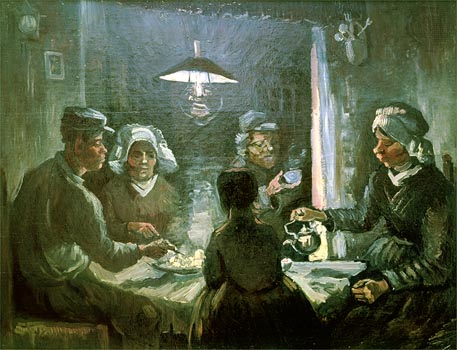
---Crazy as mudbugs on a hot griddle. Or was he? What if that famous incident actually had more to do with hunger and malnutrition than with mental illness? “Great art is not made on a full stomach,” proclaimed British journalist Jonathan Jones in his May 17, 2003 article in The Guardian, “Painting on Empty.” Jones takes his readers on a tour through history, visiting artists like Paul Gauguin, Joan Miró, and—of course—Vincent van Gogh. Miró frankly admitted that hunger was his muse: “Hunger was a great source of hallucinations. I would sit for long periods looking at the bare walls of my studio trying to capture these shapes on paper or burlap.” As popular myth has it, many are the starving artists and writers throughout history whose odd personalities made them appear possessed, ridden by demons and riven by nightmares... click for more.
Hans Abbing has listed five myths for the arts:
1. Making authentic art will be endlessly rewarding. Even when no other rewards are forthcoming, artists receive ample private satisfaction.
2. Talent in the arts is natural or God given.
3. Certain talents in the arts will only appear at a later point in someone’s career.
4. Success in the arts depends exclusively on talent and commitment.
5. Everyone has an equal chance in the arts.
And so the myths and delusions about the kinds of chances artists have in the arts, chances that are unthinkable in any other field with its diplomas, old-boys-networks etc, continue to beguile the would-be artists. Read More:http://blog.ivanpope.com/2004/04/why_are_artists.html
Beginning in the nineteenth-century, much of art and aesthetics represented a conscious attempt to defend the special status of the artwork from the banality of bourgeois capitalism. More specifically, the cult of “pure” art is a response to mechanical reproduction of artworks that threatens to strip the works of what Benjamin called its “aura” , its original context. Its a losing battle as the work of Koons or Hirst will attest to; most best-selling modern art conforms perfectly to Guy Debord’s Societe du Spectacle, and the idea of obsolescence.
Obviously there was a reality of artistic reproduction throughout history,with woodcuts,hand copies and lithographs , although modern mechanical reproduction and its apotheosis in music like i-tunes, introduced a new and revolutionary change in the experience of the artwork . With mechanical reproduction, which appeared in its most radical forms in film and photography,unlimited images of an original are circulated, all of which lack the “authentic” aura of their source. Its a process that both affects and is the effect of changing social conditions in whi
#8220;all previously unique and sacred institutions have become equal” ( Benjamin)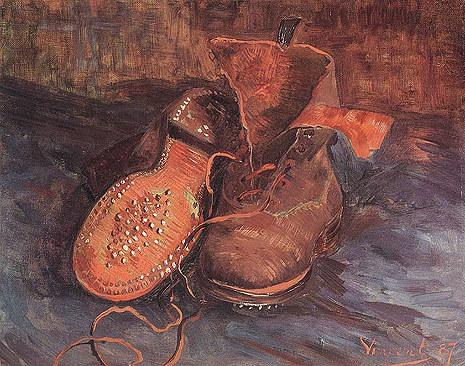
---In general, analyses of his erratic behavior focus very little, if at all, on his starved state as a possible trigger for his epileptic attacks and depressions or simply as an underlying causative factor for his somewhat unusual behavior between attacks. Few experts discuss specifically the effects of long-term starvation in relationship to van Gogh’s behavior and his art. Only one expert, Wilfred Arnold, in his Vincent van Gogh: Chemicals, Crises, and Creativity, examines van Gogh’s life from a rigorous all-encompassing medical point of view. Arnold concluded, among other things, that van Gogh’s habit of licking his brushes clean might have caused lead poisoning, since he used lead-based paints. Looking at van Gogh’s character through the prism of hunger is intriguing. Beneath van Gogh’s sheer, overwhelming poverty was an underlying text of religious asceticism, associated with fasting, similar to that which he practiced during his time as an evangelical lay preacher in the Borinage mining area of central Belgium.---
…I MAY BE POOR, BUT NOT MY ART
POVERTY MAY KILL ME, BUT NOT MY ART
POVERTY WON’T STOP ME MAKING ART
MAY POVERTY COME, I WILL MAKE ART
I WON’T SURRENDER BECAUSE OF POVERTY
MY ART AND I WILL SURVIVE FROM POVERTY
MY ART MAKES ME STRONG TILL THE END
I WON’T BEG YOU, BECAUSE I HAVE MY ART
I WON’T GIVE UP ON MY ART BECAUSE OF POVERTY
MY ART MAKES ME POOR, BUT NOT MISERABLE
MY POVERTY IS NOT MISERABLE
CHOOSING ART, I ACCEPT THE RISK OF BECOMING POOR
YES TO ART, YES TO POVERTY
MY ART GIVES ME THE COURAGE TO CHOOSE POVERTY
THE COURAGE TO STAY POOR…
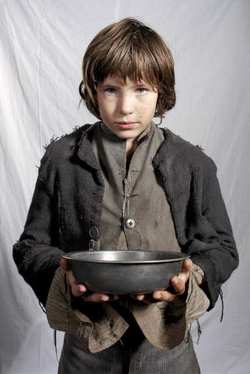
Sherry Stern:According to new research announced today by the National Endowment for the Arts, working artists are unemployed at a higher rate than other workers, and at a rate that is rising more rapidly than other professions. Presumably as a result, more artists are leaving their profession.
“…over the last one hundred and fifty years artists and the arts have become symbols of an alternative to the bourgeois lifestyle. It was a romantic, not a realistic alternative; and this probably added to its allure. Since Romanticism, society has worshipped authentic and sacred art. Art consumers often try to identify with one or more of their favourite artists. By listening to their works or by surrounding themselves with their works they share a little of the artist’s uniqueness. Artists are adored. In the market, this tends to lead to extremely high prices as well as high incomes for a very small select group of artists.”
However, Abbing shows that this idea is fundamental to how the economy of the arts keeps most artists in actual poverty (even taking into account the 2nd jobs, and financial support from their families, as well as government subsidies, grants and donations, the result is still actual poverty). The key is at the end of the last quote, regarding the “high incomes for a very small select group of artists.” The idea that no price is too high to pay for such mystical heights keeps prices high, but in a celebrity obsessed culture where Damien Hirst et al are hugely financially successful and renowned, wannabe artists sign up for art college in their droves, hoping for a shot at immortality or fame, hoping that they can be one of the “winner-takes-all” crowd. The reality is that there are far too many artists… Read More:http://artbizness.wordpress.com/2009/07/03/why-are-artists-poor-pt-3-the-gifted-artist/
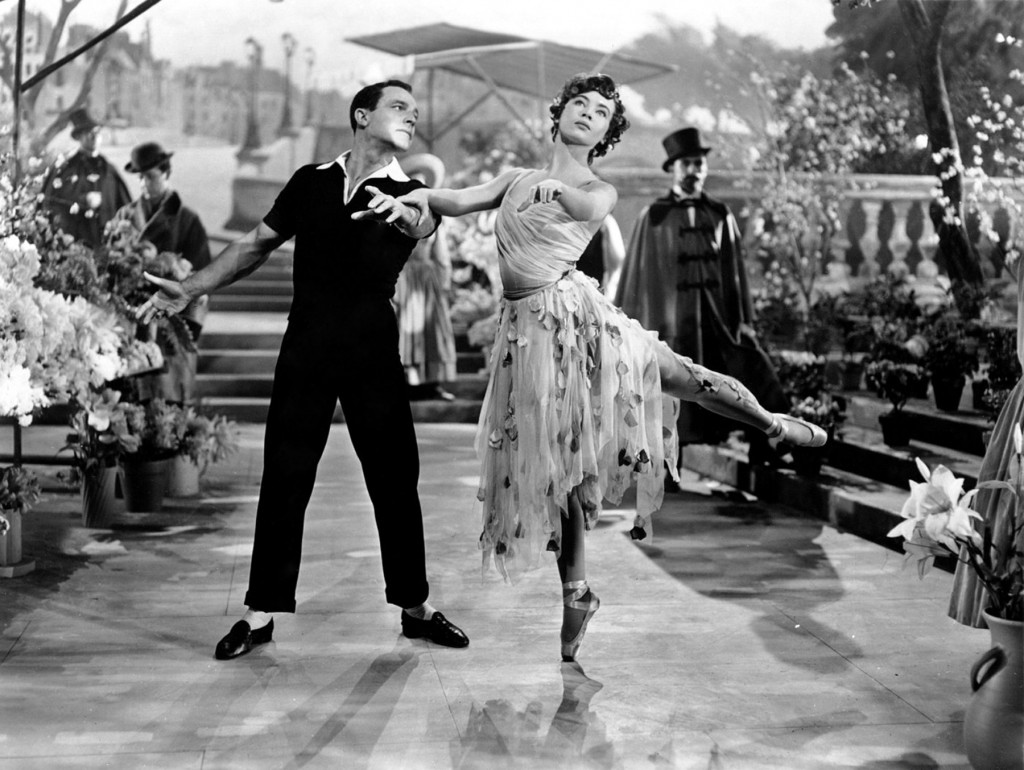
---American Jerry Mulligan, a former G.I. and fledgling painter who stayed in Paris after World War II, loves his life as a struggling artist on the Left Bank. He is friendly with his neighbors, especially the local children and cynical American Adam Cook, a concert pianist living on a succession of fellowships. One day, when Jerry is particularly low on money, he goes to Montmarte and sets up an impromptu exhibit of some of his work, hoping to sell something to a tourist. He has little success until Milo Roberts, an American heiress living in Paris, admires his paintings and buys two. Because she does not have enough cash with her, she invites Jerry to her hotel to get the money. Jerry shows little enthusiasm for her chauffeur-driven car and expensive hotel room, but accepts an invitation to a party she is giving that night. When he returns, the provocatively dressed Milo reveals that the party is only for herself and Jerry. Thinking that she wants a gigolo, Jerry is insulted and wants to return the money for his paintings, but she convinces him that she is a patron of the arts and only wants to help him....
YOU MAY CALL ME A POOR ARTIST, BUT NOT A FAILED ARTIST
DON’T DARE TO CALL MY ART POOR, JUST BECAUSE I AM POOR
YOU MAY CALL ME POOR, BUT NOT MY ART
ART IS LABOUR
I WILL FACE MY POVERTY WITHOUT FEAR
I WON’T NEGLECT PEOPLE DYING INSTEAD OF US
DO YOU EVER COME TO THINK OF DYING FOR ART?
DON’T LET MY ART LABOUR KILL ME
I DON’T SURRENDER, I CHOOSE ART
MY LABOUR WILL SUGGEST YOU ANOTHER VIEW TO YOUR DREAMWORLD
RECOGNITION NOT DISREGARD: ART LABOUR
FANTASIZE, GIVE FORM, TALK ABOUT IT: ART LABOUR
I’M SO SORRY TO ASK YOU AGAIN, BUT WON’T YOU FEED ME A BIT, I’M A LABOURER OF ART Read More:http://www.artallowsmethefreedomtochoosepoverty.net/
We need to see that the role of art has been almost totally subordinate and submissive to the role of consumerism.Since consumption is not about conformity, but about distinction, the role of art is simply that of a commodity; art today that criticizes mass society such as Cindy Sherman or Richard Prince among others, simply helps drive the consumerist wheel. Why? because this type of artistic rebellion,and not conformity, is what enhances and expands on the competitive structure that is at the intersection between consumption and well-being. It seems as long as we continue to value individuality in its raw form-greed, selfishness, trickle-down- and as long as that version of individuality manifests and is extolled through our possessions, normative democracy based on property law, we can expect to live in a consumerist society whose symptons may no longer be able to simply patched and taped together at a future time.
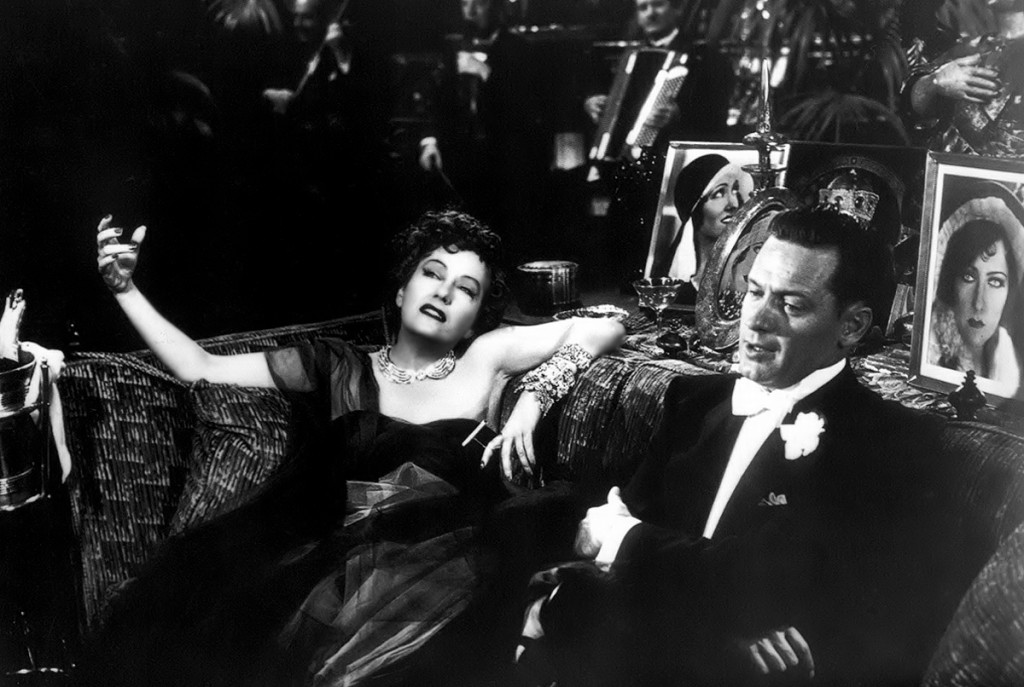
---The greatest film ever made about Hollywood, Sunset Blvd. fuses fact and fiction so perfectly as to replace both with a spectral, hallucinatory intensity that imbues every character with their imminent death - from screenwriter Joe Gillis (William Holden), who narrates from beyond the grave, to aging silent icon Norma Desmond (Gloria Swanson), who takes him in after his car breaks down, and hires him to script her comeback, to her manservant (Erich von Stroheim) and collection of 'waxworks' (including Buster Keaton), all of whom allow her to maintain the fantasy that Cecil B. DeMille will be prepared to direct it...
ADDENDUM:
As mainstream consumers bitch and moan about the lack of diversity in music, literature, dance, and film, independent artists channel their frustration into making art that rarely meets the ear or eye. Each day, a handful of independent artists receive the opportunity to carry their work into the mainstream, but most albums, shows, and books flop due to the twisted love-hate relationship that mainstream consumers share with mainstream monotony.
The consumer does not decide what’s hot and artistic talent is not a prerequisite for mainstream success. In fact, mass marketing campaigns, repeated radio plays, Oprah’s book endorsements, and powerhouse-funded films decide who has got “next” in every artistic industry. And most consumers, too lazy to venture beyond the latest talk show endorsement or popular deejay’s “exclusive shit” rhetoric, eat exactly what they’re fed, despite issuing complaints regarding the creative lull that tends to plague every artistic industry. Originality is rarely “it” anymore and if an independent artist wants to go mainstream, they tend to sacrifice innovation for fame and success. Read More:http://clutchmagonline.com/2011/05/why-artist-equals-poor/
————————————————————————-

---Daniel Celentano."Festival" the exhibition, called "1934: A New Deal for Artists." The Ticket notes: When President Roosevelt unveiled his New Deal programs during the Great Depression, he sought relief for every American, including artists. After all, said Harry Hopkins, the chain-smoking New Yorker FDR put in charge of the program, "Hell, they've got to eat just like other people!"
The National Endowment for the Arts has released a 140-page report on the state of the country’s artists, reports the Associated Press. According to the study, “Artists in the Workforce: 1990–2005,” around 2 million Americans identify themselves as artists, falling into 11 categories. The report reinforces the term, and stereotype, of the “struggling artist,” as the average income for an American artist is $34,800 — well below the average for professionals. Dana Gioia, the NEA chairman, believes that the solution lies in arts education, telling the AP, “You have underemployed and highly trained musicians, actors, dancers, and other artists who could easily provide arts education to our schools.”…
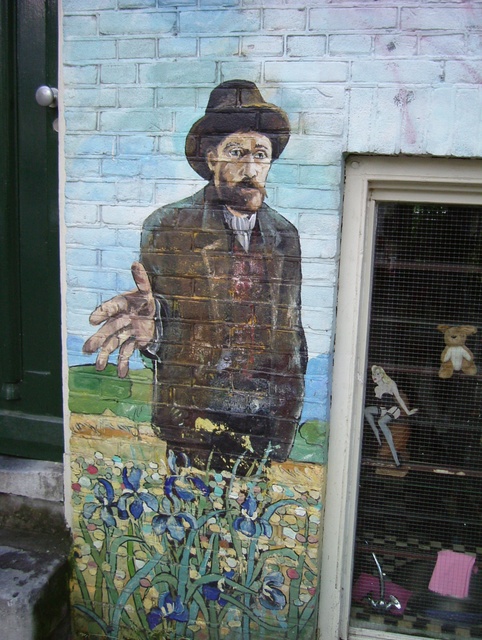
---Vincent van Gogh was indeed the stereotypical starving artist. Clearly his poor eating habits contributed a great deal to his physical and mental suffering. We can’t be absolutely sure of anything without having access to Vincent himself, in the flesh, but the evidence suggests very strongly that starvation, or at least chronic hunger, played a huge role in guiding Vincent’s life. He bought paint and canvases and brushes before he bought food, so his hunger for art taking precedence over his hunger for food.----click image for more
…The NEA also found that the number of artists in the U.S. has nearly tripled since 1970. The number of designers, who make up almost 40 percent of all artists, has increased to around 780,000 in 2005 from 600,000 in 1990. San Francisco has the highest number of artists per capita, with Santa Fe in second place, while Los Angeles-Long Beach has the most artists overall (140,000), followed by New York (133,000). The percentage of Hispanic, Asian, or American Indian artists grew from 9 percent in 1990 to 15 percent in 2005.
Gioia says that the report helps disprove the stereotype of artists as unemployed, marginal, and passive. “If you look at the statistics,” he says, “artists represent one of the major occupations in the American economy. These are highly trained, productive, and highly entrepreneurial people.” Read More:http://en.artron.net/news/news.php?newid=52152&column_id=61
——————————————————-
Walter Benjamin:“Magician and surgeon compare to painter and cameraman. The painter maintains in his work a natural distance from reality, the cameraman penetrates deeply into its web. There is a tremendous difference between the pictures they obtain. That of the painter is a total one, that of the cameraman consists of multiple fragments which are assembled under a new law. Thus, for contemporary man the representation of reality by the film is incomparably more significant than that of the painter, since it offers, precisely because of the thoroughgoing permeation of reality with mechanical equipment, an aspect of reality which is free of all equipment.” Read More:http://www.wordsinspace.net/course_material/fmt/BenjaminWorkOfArt.pdf





 COMMENTS
COMMENTS